WG-827型商务网关说明书
ICP DAS USA 产品说明 - 工业级 Modbus 网关说明书
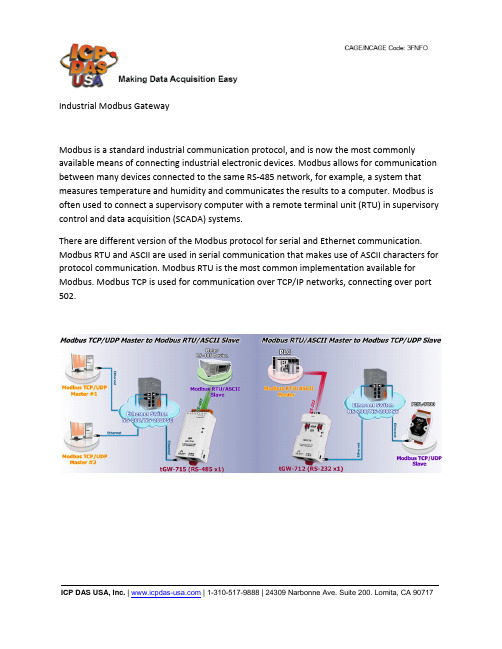
Industrial Modbus GatewayModbus is a standard industrial communication protocol, and is now the most commonly available means of connecting industrial electronic devices. Modbus allows for communication between many devices connected to the same RS-485 network, for example, a system that measures temperature and humidity and communicates the results to a computer. Modbus is often used to connect a supervisory computer with a remote terminal unit (RTU) in supervisory control and data acquisition (SCADA) systems.There are different version of the Modbus protocol for serial and Ethernet communication. Modbus RTU and ASCII are used in serial communication that makes use of ASCII characters for protocol communication. Modbus RTU is the most common implementation available for Modbus. Modbus TCP is used for communication over TCP/IP networks, connecting over port 502.The tGW-700 is a Modbus TCP to RTU/ASCII gateway that enables a Modbus/TCP host to communicate with serial Modbus RTU/ASCII devices through an Ethernet network, and eliminates the cable length limitation of legacy serial communication devices. The module can be used to create a pair-connection application (as well as serial-bridge or serial-tunnel application), and can then route data over TCP/IP between two serial Modbus RTU/ASCII devices, which is useful when connecting mainframe computers, servers or other serial devices that use Modbus RTU/ASCII protocols and do not themselves have Ethernet capability.The new read-cache function is used to store previous requests and responses in the memory buffer of the tGW-700 module. When other HMI/SCADA master controllers send the same requests to the same RTU slave device, the cached response is returned immediately. This feature dramatically reduces the loading on the RS-485 bus communication, ensures faster TCP responses, and improves the stability of the entire system.DHCP minimizes configuration errors caused by manual IP address configuration, such as address conflicts caused by the assignment of an IP address to more than one computer or device at the same time. The tGW-700 module supports the DHCP client function, which allows it to easily obtain the necessary TCP/IP configuration information from a DHCP server. The module also contains a UDP responder that transmits its IP address information in response to a UDP search from the eSearch utility, making local management more efficient.The tGW-700 module also features a powerful 32-bit MCU to enable efficient handling of network traffic, and also has a built-in web server that provides an intuitive web management interface that allows users to modify the configuration of the module, including theDHCP/Static IP, the gateway/mask settings and the serial port settings.The module contains a dual watchdog, including a CPU watchdog (for hardware functions) and a host watchdog (for software functions). The CPU watchdog automatically resets the CPU if the built-in firmware is operating abnormally, while the host watchdog automatically resets the CPU if there is no communication between the module and the host (PC or PLC) for a predefined period of time (system timeout). The dual watchdog is an important feature that ensures the module operates continuously, even in harsh environments. In addition, the tGW-700 series (for i version) also adds 3000 VDC isolation and +/-4 kV ESD protection component that diverts the potentially damaging charge away from sensitive circuit to protects the module and equipment from the sudden and momentary electric current.The tGW-700 module offers true IEEE 802.3af-compliant (classification, Class 1) Power over Ethernet (PoE) functionality using a standard category 5 Ethernet cable to receive power from a PoE switch such as the NS-205PSE. If there is no PoE switch on site, the module will also accept power input from a DC adapter. The tGW-700 module is designed for ultra-low power consumption, reducing hidden costs from increasing fuel and electricity prices, especially when you have a large number of modules installed. Reducing the amount of electricity consumed by choosing energy-efficient equipment can have a positive impact on maintaining a green environment.The module is equipped with a male DB-9 or a removable terminal block connector to allow easy wiring. Based on an amazing tiny form-factor, the tGW-700 achieves maximum space savings that allows it to be easily installed anywhere, even directly embedded into a machine. It also supports automatic RS-485 direction control when sending and receiving data, thereby improving the stability of the RS-485 communication.tGW-700 series offers different combination of number of ports to select, including RS-232, RS-422, and RS-485 for your applications.If you have other industrial communication requirements or have questions, we can certainly help you to choose the best solution. Please call our technical support team at (310) 517-9888 X102。
中国电信 商务领航定 制网关1-1 客户使用手册

商务领航定制网关 1-1 客户使用手册 z 预先设置好的无线网络名称(SSID)为“ChinaNet-XXXX”,名称
的后四位“XXXX”为 4 位随机字符或数字。具体的 SSID 名称和无 线网络接入密码详见本产品的外壳标签。 z 可以修改无线网络名称(SSID)的后四位,具体修改步骤请参见 第 6 章无线组网部分。 配置无线客户端软件的步骤如下(以使用 Windows 自带的无线连接工具为例): 步骤 1 如下图所示,点击【开始】>【设置】>【网络连接】:
8 快速故障定位 ........................................................................................ 14 9 技术规格 ................................................................................................ 16
第4页
编号
名称
(WPS)
(7)
USB 指示灯 (USB)
后面板
商务领航定制网关 1-1 客户使用手册
状态 闪烁 常亮
含义/功能 按下按钮时闪烁(约 2 分钟) 已连接到 USB 设备
编号 (1) (2) (3)
(4) (5) (6)
名称 Power Line
Reset
固定交换口 LAN1~4 WPS WLAN
常亮
以太网指示灯
不亮
(LAN4~LAN1) 闪烁
常亮
无线指示灯
不亮
(WLAN)
闪烁
常亮
WPS 指示灯
常亮
含义/功能 表示电源没有接通 表示电源接通 表示 DSL 线路断开表示 DSL 链路正在同步 表示 DSL 链路同步完成 表示网络没有连接 有数据传输 表示网络已连接 表示链路没有连通 表示有数据收发 表示链路已经连通 表示链路没有连通 有数据传输 表示链路已经连通 开启后常亮
WG-315商务网关2.6版使用说明书
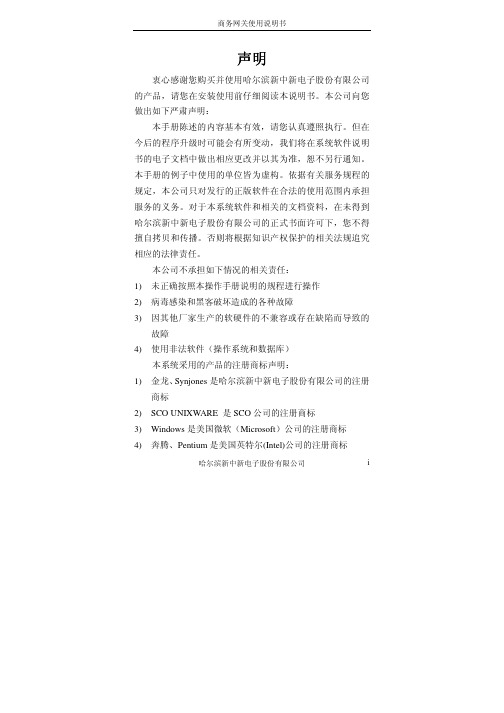
2 术语定义 ............................................................................... 8
AT-MQTT 网关用户指南说明书
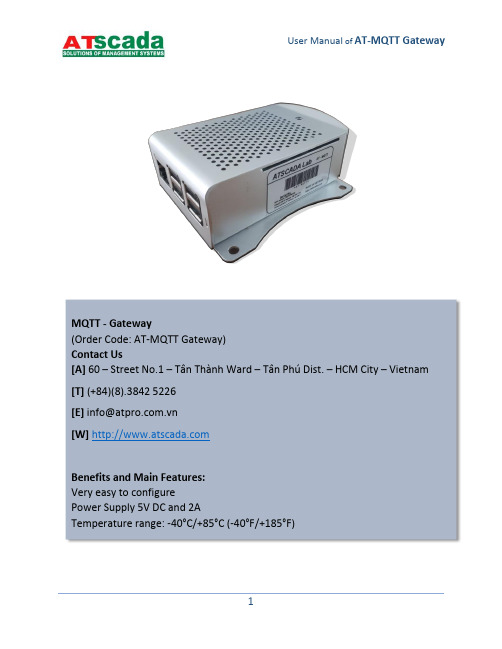
MQTT - Gateway(Order Code: AT-MQTT Gateway)Contact Us[A] 60 – Street No.1 – Tân Thành Ward – Tân Phú Dist. – HCM City – Vietnam [T] (+84)(8).3842 5226[E] **************.vn[W] Benefits and Main Features:Very easy to configurePower Supply 5V DC and 2ATemperature range: -40°C/+85°C (-40°F/+185°F)Table of ContentsINTRODUCTION (2)CONFIGURATION (4)Prerequisites............................................................................................................................................... Gateway configuration...............................................................................................................................Step 1 ......................................................................................................................................................Step 2 : (6)Step 3 : (7)Step 4 : (8)Step 5 : (8)Subcribe and publish the MQTT topic associated with each Tag. (10)INTRODUCTIONThe AT-MQTT Gateway is Modbus RTU master to MQTT Converter.It allows to publish the data read from Modbus Slaves into MQTT Server.The gateway allows fast and easy access to IoT world and is compatible with IoT Servers that support MQTT protocol.Example of connection:AT- MQTT-GatewayCONFIGURATIONPrerequisitesBefore configuring communication parameters via Web Interface, you need to connect the gateway to internet network by wire or Wi-Fi connection. For changing IP of the gateway, kindly search on “how to change raspberry IP”.Gateway configurationYou need to access to web Interface (the server runs on your gateway) in order to perform the following:Define the parameter of MQTT.Define the parameter of Modbus RTU channel.Define which Modbus memory addresses sent to MQTT serverChange your account and password.Reboot the gateway to update your configuration.Step 1: Access Web interface with url: “IP:9000”, if you use default LAN IP, the url is “192.168.1.100:9000”.You are prompted to enter username and password. The default user name is “admin”,the default password is “admin”. Then click Login button and you will be logged into web interface:The page is divided in different sections in order to define the different parameters of the gateway:∙ModbusRTUCommunication∙MQTTCommunication∙Tags∙AccountStep 2:Define the parameter of Modbus channel.“Port Name”: the port name to use (/dev/tty/USB0)“Baud Rate”: the baud rate of the serial line.“Databits”: the data bits of the serial line.“Parity”: the parity of the serial line.“Stopbits”: the stop bits of the serial line.“Response Timeout”: the time out of the serial line.“Period”: the period is the Cycle of Modbus master-slave query-response.Click “Apply” to update your configuration.Step 3:Define the parameter of MQTTThe section is used to define the main parameters of MQTT. Meaning of each row:“MqttClient ID”: Mac address of your gateway and cannot be changed.“Server Url”: Url or the IP Address of the defined MQTT server.“Server Port”: the port used for defined MQTT communication.“Username”: the username for the connection to MQTT server.“Password”: the password for the connection to the MQTT server.“Clean Section”: if set to “True”, the last MQTT message is deleted by the server and the client in case of missing ACK. If it is set to “false”, theServer and the client hold the last MQTT messages and , in case ofincorrect disconnection or missing ACK, they try to send again since allthe ACK messages are exchanged correctly (valid only for Qos 1 and QoS2).“Keep Alive”: the delay which the keep alive message is sent on MQTT.“Retained”: if set to “true”, the retained flag is enabled. The MQTT server will hold the last topic published.“QoS”: the Qos level.Clic k “Apply” to update your configuration.Step 4: Define which Modbus memory addresses are sent to MQTT serverMeaning of each field:“Tag Name”: the name of tag. This name must be unique.“Slave Id”: the address of the Modbus device.“Type”: the data type of the Tag. It is possible to choose between the following :o Coil Statuso Input Statuso Holding Registero Input Register“Address”: the starting address of the Tag.“Number Point”: the number of consecutive points.Click “Add” to create new tag.Click “Edit” to redefine tag.Click “Delete” to delete tag.Step 5: After completely configure the Gateway, Log out of Web Interface and Reboot your Gateway.Subscribe and publish the MQTT topic associate with each Tag.Each Tag is sent by gateway to MQTT server by publishing to a MQTT topic. These topics have name in format: Mac address/slave Id/Tag Name.For writing value to each Tag, gateway subscribes to a MQTT topic. These topics have name in the format: Write/Mac address/slave Id/Tag Name.For Example: A gateway has Mac address is “B827EB087532”. If you define a Tag named “Tag 1”and your Modbus Slave ID is “1”, The value of Tag is published to topic name : “B827EB087532/1/Tag1 “ and subscribed to topic name: “Write/ B827EB087532/1/Tag1”.Data Format is in byte array: timestamp (8 byte), Value of Tag, Status (1 byte). The Status byte means: 1 is for good connection, 0 is for bad connection.Other MQTT clients read data of Tag by subscribing to the topic that gateway has published to MQTT server.Other MQTT clients write data to Tag by publishing value to Topic that gateway has subscribed. The Value is written to Tag must be the same type with type of Tag.Change your Web Interface AccountThe default User name is “admin” and the default Password is “a dmin”. After logging in to Web interface you can change your user name and password then click “Update Account”to update your account.。
827智能定位器使用说明书

827系列智能阀门定位器随着计算机、控制、通讯、网络等技术的发展,计算机控制系统逐步从集散系统(Distributed Control Systen,DCS)走向以现场总线位基础的分布式现场总线控制系统(Fieldbus Control System,FCA)。
827智能总线阀门定位器为满足现场总线控制需要而设计,广泛应用于石化、冶金、化工、电力、轻工、炼油场合。
827智能阀门定位器让调节阀拥有大脑和灵魂!通常安装和调试阀门定位器总是花费许多时间,827智能阀门定位器使得这一切变得简单容易。
尤其是其结构紧凑无外接管路地和812系列气动执行器的连接创建了无管路的快速安装。
其独到的构造改变了多年来定位器安装的潮流。
它可以将阀位变送器集成在定位器内部,也可以将限位开关集成在定位器内部,有效地简化安装和配置。
其可以简单地安装到任何阀门上,通过友好界面,快速设置,自动标校和自动整定。
其汉化的语言界面无以伦比的性价比将引起定位器的革命性潮流。
一、概况827系列智能阀门定位器是一种新型智能阀门定位器产品,安装在气动执行器上具有丰富功能,可实现即时通讯,能直接到调节器的4-20mA输出回路上。
定位器接收标准电流信号或计算机信号,驱动气动执行机构使阀门达到给定位置。
智能定位器所有参数的调整由电子模块进行全数字化运算和操作。
定位器底座和壳罩采用能够适应工厂中恶劣环境的轻质合金制造,并进行了防腐处理,其安装连接附件均采用经过钝化处理的不锈钢材质,具有高的使用寿命。
827智能型定位器以它精确的外观设计、模块化内部结构、非常方便的调试及维护而脱颖而出。
827型智能定位器,用于气动直行程或角行程执行机构。
它的核心是微处理器CPU,所有程序的处理运算皆在此。
输入信号及位置反馈经过12位20ms采样的A/D转换器进行处理,从而保证了信号处理的精度及快速性。
CPU的供电直接取自输入信号。
操作程序包括用于自动调整参数的自整定过程及自适应控制程序,用于精确定位的优化控制操作。
gsp827中文说明书

Power Frequency Magnetic Field EN 61000-4-8 : 1993
------------------------◎ Safety
Voltage Dips/ Interrupts EN 61000-4-11: 1994
Low Voltage Equipment Directive 73/23/EEC & amended by 93/68/EEC
EN 55011: 1998 class A
EN 61000-4-2: 1995+A1:1998
Current Harmonic EN 61000-3-2: 2000 Voltage Fluctuation EN 61000-3-3: 1995
Radiated Immunity EN 61000-4-3: 1996+A1:1998 Electrical Fast Transients EN 61000-4-4: 1995
EN 61326-1: Electrical equipment for measurement, control and laboratory use –– EMC requirements (1997+A1: 1998+A2: 2001)
Conducted and Radiated Emissions Electrostatic Discharge
7. 功能目录表 ................................................................................................................................................................. 22 7.1 主要功能............................................................................................................................................................... 22 7.2 测量功能............................................................................................................................... 错误!ቤተ መጻሕፍቲ ባይዱ定义书签。 7.3 控制功能............................................................................................................................... 错误!未定义书签。 7.4 状态功能............................................................................................................................... 错误!未定义书签。
GWS-HZW1 Home Gateway 产品说明书
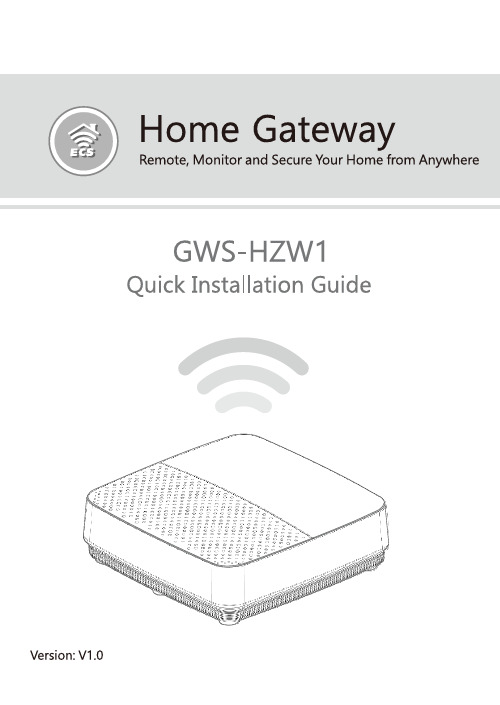
4
Product Feature
Connectivity LAN port, support WiFi and Bluetooth Interface DC-in port, USB port, SIM card slot, reset, LAN port, Debug client port, power switch Dimensions & Weight Dimension: 128 × 117 × 38.7 mm Weight: 335 g Environmental Conditions Operational temperature range: 0°C to +45°C (32°F to 113°F) Storage temperature range: -20°C to +60°C (-4°F to 140°F)
14
4G LTE Network Coniguration
Input the following commands. Choose one ot the following three commands(1~3) based on the corresponding LTE module. - 1. pppd call mu609 & --> Huawei ME909s 120 module
Step 2. Activate the network interface (e.g. eth0). root@WR-IntelligentDevice:~# ifconig eth0 up Step 3. If the interface matching failed, please edit /etc/ network/interfaces directly and then either restart the service or reboot the system to make the change effect.
中国普天CP_GW2100商务领航定制网关配置与维护手册v1.1
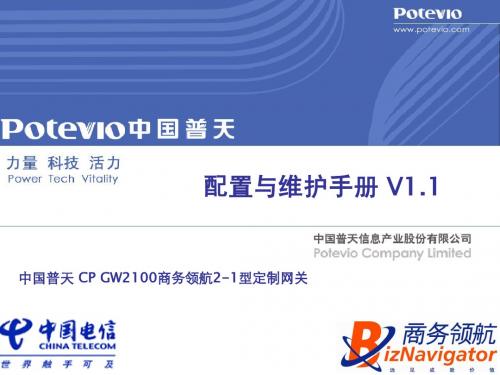
2014-6-25
中国普天 版权所有
50
虚拟局域网(VLAN)的设置和划分方法很简单,但虚拟局域网的划分又十 分的重要,在很多解决方案中都要进行虚拟局域网的划分,且虚拟局域网 有效的隔离了广播域,一定程度上阻止了一些广播病毒及风暴的发生。虚 拟局域网的划分方法总共分两步:一、添加虚拟局域网;二、划分端口。 如下:
2014-6-25 中国普天 版权所有 36
链路备份和负载分担
上行接入有三条链路,双WAN和3G,双 WAN链路做负载分担,3G为WAN链路 做备份。在两条上行链路的情况下,可 以在负载分担的基础上做相互的备份。
双WAN上行
3G ChinaNet-abcd VLAN1 VLAN2 VLAN3 VLAN4
2014-6-25 中国普天 版权所有 47
(2)防欺骗
一般欺骗的种类有欺骗网关ARP、欺骗主机ARP,针对不同的ARP欺骗,可 以采取同样的方式进行处理,防欺骗的方法有:关闭ARP学习、静态绑定、 设置端口保护、自定义发包。其中关闭ARP学习和静态绑定是最有效的防欺 骗方法,下面介绍各种方法的配置:
2014-6-25
中国普天 版权所有
34
DNS和NAT配置完成后,进行流量触发,界面显示连接成功后,即表示 3G拨号成功。
2014-6-25
中国普天 版权所有
35
产品功能配置
设备升级 基本上网功能 链路备份和负载分担 防ARP攻击功能 虚拟局域网(vlan)
安全隔离
访问限制 强制门户功能 QoS保证 搭建外部服务器功能 数据专线(VPN)的应用 管理功能
安全隔离
访问限制 强制门户功能 QoS保证 搭建外部服务器功能 数据专线(VPN)的应用 管理功能
潮流网络 GWN780X 二层千兆网管型交换机 用户手册说明书

深圳市潮流网络技术有限公司GWN780X二层千兆网管型交换机用户手册目录欢迎 (10)产品概述 (11)技术规格 (11)初始安装 (15)设备清单 (15)GWN780X端口 (15)桌面安装 (19)壁挂安装 (20)19”机架安装 (20)启动并连接GWN780X (21)了解GWN780X (26)LED指示灯 (26)访问和配置 (27)通过Console口登录 (27)通过SSH远程登录 (27)通过GWN.Cloud/GWN Manager配置 (27)通过Web UI登录 (27)Web GUI语言 (28)Web GUI配置 (29)搜索 (30)概览界面 (30)系统信息 (30)端口信息 (31)以太网业务 (34)端口基本配置 (34)巨型帧 (35)流量统计 (36)端口自动恢复 (36)链路聚合 (37)链路聚合组 (37)端口设置 (38)LACP (40)MAC地址表 (41)动态地址 (41)静态MAC地址 (42)黑洞地址 (43)端口安全地址 (43)VLAN (44)VLAN端口设置 (46)VLAN端口成员 (47)语音VLAN (48)OUI (49)生成树 (50)STP端口设置 (51)MST实例 (53)组播业务 (56)IGMP Snooping (56)IGMP全局设置 (56)IGMP路由器端口 (58)IGMP组播地址 (59)IGMP组播策略 (60)IGMP组播端口 (60)MLD Snooping (61)MLD局设置 (61)MLD路由器端口 (64)MLD组播地址 (65)MLD组播策略 (66)MLD组播端口 (66)POE (68)全局 (68)POE预留功率 (68)接口 (69)QoS (70)端口优先级 (70)优先级映射 (71)队列调度 (73)队列整形 (74)端口限速 (74)安全业务 (76)风暴控制 (76)端口安全 (78)端口隔离 (80)ACL (80)IPv4ACL (80)IPv6ACL (81)链路层ACL (82)ACL绑定 (83)IP源防护 (84)攻击防范 (85)动态ARP检查(DAI) (86)RADIUS (87)TACACE+ (88)AAA (89)802.1X (89)DHCP Snooping (90)DHCP Option82 (91)DHCP端口设置 (91)DHCP端口数据统计表 (92)SNMP (94)视图管理 (95)组管理 (95)团体管理 (96)用户管理 (97)通知管理 (98)Trap事件 (99)维护和故障排除 (100)诊断 (100)日志 (100)Ping (101)路由跟踪 (101)镜像 (102)光模块 (103)RMON (103)RMON统计组 (104)RMON历史组 (104)RMON事件组 (105)RMON告警组 (105)LLDP/LLDP-MED (106)LLDP全局设置 (106)LLDP MED网络策略 (107)LLDP MED端口设置 (108)LLDP设备信息 (109)邻居信息 (110)LLDP数据统计 (110)更新和部署 (112)升级 (112)备份和恢复 (112)时间设置 (113)访问控制 (113)用户管理 (114)图目录图1GWN780X包装清单 (15)图2GWN7801/GWN7801P端口 (15)图3GWN7802/GWN7802P端口 (16)图4GWN7803/GWN7803P端口 (18)图5GWN780X桌面安装 (19)图6GWN780X壁挂安装 (20)图7GWN780X L型支架安装 (21)图8GWN780X机架安装 (21)图9交换机接地 (21)图10交换机上电 (22)图11连接电源线防跳闸(可选)-part1 (22)图12连接电源线防跳闸(可选)-part2 (23)图13连接RJ45接口 (23)图14连接SFP接口 (24)图15连接SFP接口 (25)图16GWN780X Web页面 (28)图17Web GUI显示语言-登录页面 (29)图18Web GUI显示语言-开始页面 (29)图19Web GUI配置 (29)图20搜索 (30)图21系统信息页面 (31)图22端口信息 (32)图23端口基本配置 (34)图24巨型帧 (35)图25流量统计 (36)图26端口自动恢复 (37)图27链路聚合组 (38)图28端口设置 (39)图29LACP (40)图30动态MAC地址 (42)图31静态MAC地址 (42)图32黑洞地址 (43)图33端口安全地址 (44)图34添加VLAN (45)图35编辑VLAN (45)图36VLAN端口设置 (47)图37VLAN端口成员 (48)图38语音VLAN (48)图39OUI (50)图40生成树-全局设置 (51)图42生成树-编辑端口设置 (52)图43MST实例 (54)图44MST端口设置 (55)图45编辑MST端口 (55)图46IGMP全局设置 (56)图47IGMP Snooping编辑VLAN (57)图48IGMP路由器端口 (59)图49IGMP组播地址 (60)图50IGMP组播策略 (60)图51IGMP组播端口 (61)图52MLD Snooping全局设置 (62)图53MLD Snooping编辑VLAN (63)图54MLD路由器端口 (65)图55MLD组播地址 (66)图56MLD组播策略 (66)图57MLD组播端口 (67)图58POE-全局 (68)图59POE预留功率 (68)图60POE接口 (69)图61端口优先级 (70)图62COS映射 (72)图63DSCP映射 (72)图64IP映射 (73)图65队列调度 (74)图66队列整形 (74)图67端口限速 (75)图68风暴控制 (77)图69端口安全 (79)图70端口隔离 (80)图71IPv4ACL (81)图72IPv6ACL (82)图73链路层ACL (83)图74ACL绑定 (84)图75IP源防护 (84)图76四元绑定表 (85)图77攻击防范 (86)图78DAI (86)图79端口数据统计表 (87)图80RADIUS (88)图81TACACE+ (89)图82AAA (89)图83802.1X端口模式 (90)图85DHCP Snooping (91)图86Option82 (91)图87DHCP端口设置 (92)图88DHCP端口数据统计表 (93)图89SNMP全局设置 (94)图90视图管理 (95)图91组管理 (96)图92团体管理 (97)图93用户管理 (98)图94通知管理 (99)图95Trap事件 (99)图96诊断-日志 (100)图97日志服务器 (101)图98Ping (101)图99路由跟踪 (102)图100端口镜像 (103)图101光模块 (103)图102RMON-统计组 (104)图103RMON-历史组 (105)图104RMON事件组 (105)图105RMON-告警组 (106)图106LLDP全局设置 (107)图107LLDP端口设置 (107)图108LLDP MED网络策略 (108)图109LLDP MED端口设置 (109)图110LLDP设备信息 (110)图111邻居信息 (110)图112LLDP数据统计 (111)图113升级 (112)图114备份与恢复 (113)图115时间设置 (113)图116访问控制 (114)图117用户管理 (115)表目录表1GWN780X技术规格 (11)表2GWN7801/GWN7801P端口 (15)表3GWN7802/GWN7802P端口 (16)表4GWN7803/GWN7803P端口 (18)表5LED指示灯 (26)表6系统信息 (31)表7端口信息 (32)表8端口基本配置 (34)表9链路聚合组 (38)表10端口设置 (39)表11LACP (40)表12静态MAC地址 (43)表13编辑VLAN (45)表14VLAN tagged和untagged (46)表15语音VLAN (48)表16生成树-全局设置 (51)表17生成树-编辑端口设置 (52)表18IGMP全局设置 (56)表19IGMP Snooping编辑VLAN (57)表20MLD Snooping全局设置 (62)表21MLD Snooping编辑VLAN (63)表22端口优先级 (70)表23风暴控制 (77)表24安全MAC地址类型 (78)表25端口安全 (79)表26SNMP全局设置 (94)欢迎GWN7800系列是二层企业级千兆管理型交换机,是潮流网络针对中小企业客户应用量身定制的网管型交换机,满足中小型企业构建可扩展、安全、高性能的可管理智能业务网络的需求。
商务领航网关1-2和2-1配置与维护

ICG2000X-CMW520-E1809P11.BIN 设备型号标识 版本编号
三款设备都包装自MSR,只是性能、接口有所差别。 在版本号相同的情况下,功能基本相同,配置方法完全一致。 早期2-1设备使用的是16M Flash,一些新特性入SSL VPN没有合入。
8
目录
商务领航网关1-2及2-1介绍 商务领航网关的配置与维护
WAN地址:117.20.34.6 TCP 80端口映射 192.168.3.2-TCP 80 TCP 37777端口映射(隐藏) 192.168.3.2-TCP 37777 E0/8~E0/9 确定隐藏端口的方法: 1. 访问客户端安装WireShark 2. 设置好浏览器,确保打开网页所相关ActiveX插 件已经安装 3. 访问前启动WireShark抓包 4. 进行正常访问 5. 对抓包进行分析过滤,发现隐藏端口 6. 根据找出的隐藏端口添加内部映射
商务领航网关的配置与维护 目录
快速向导 设置VLAN 修改WLAN 内部服务器 地址绑定 互联网访问控制 应用限制 群组功能 内部访问隔离 QoS 3G上网 VPN-L2TP VPN-IPSec
10
快速向导(一)
快速向导能够快速的帮你完成设备的基本配置
命令行撤销可以使用undo命令
undo acl number 3400删除访问控制列表3400 undo nat outbound 3400可以在接口中的nat outbound 3400命令撤销
31
商务领航网关的配置与维护 目录
快速向导 设置VLAN 修改WLAN 内部服务器 地址绑定 互联网访问控制 应用限制 群组功能 内部访问隔离 3G上网 QoS VPN-L2TP VPN-IPSec
emerson ROC827远程操作控制器安装手册说明书

文档编号 A6175零件编号 D301251X4122006 年 3 月ROC827 远程操作控制器安装手册修订跟踪表2006 年 3 月本手册将定期修订以增加或更新信息。
每页的修订日期将显示在与页码相对的另一个页角上。
更改任何一页上的修订日期也将更新封面上显示的手册日期。
下面列出的是每一页的修订日期(如果适用):页码修订年 3 月初版 2006ROCLINK 是艾默生过程控制公司的下属公司的商标。
Emerson 徽标是 Emerson Electric Co. 的商标和服务标识。
所有其他商标均为其各自所有者的财产。
© 费希尔控制装置公司 2006. 保留所有权利。
美国印刷/flow尽管本信息在推出时尽量保证其忠实性和准确性,但费希尔控制装置公司不保证依赖此信息可获得满意的结果。
此处所含之任何信息不得视为对有关产品性能、适销性或其它任何与产品相关的事项的明示或暗示保证或担保,亦不能视为是推荐使用任何侵权的产品或过程。
费希尔控制装置公司保留在未通知的情况下更改或改进此处所述产品规格的权利。
目录第 1 章 – 常规信息 1-11.1手册内容...........................................................................................................................1-11.2硬件...................................................................................................................................1-21.2.1中央处理器 (CPU)..............................................................................................1-51.2.2处理器与内存......................................................................................................1-61.2.3实时时钟 (RTC)..................................................................................................1-61.2.4诊断监控.............................................................................................................1-71.2.5选项....................................................................................................................1-71.3FCC 信息..........................................................................................................................1-81.4固件...................................................................................................................................1-81.4.1历史数据库与事件和报警日志...........................................................................1-111.4.2流量计量回路和计量站.....................................................................................1-121.4.3流量计算...........................................................................................................1-121.4.4自动自检...........................................................................................................1-131.4.5低功耗模式........................................................................................................1-131.4.6比例积分微分 (PID)..........................................................................................1-131.4.7功能顺序表 (FST).............................................................................................1-141.5ROCLINK 800 组态软件.................................................................................................1-141.6DS800 开发套装软件......................................................................................................1-161.7扩展背板.........................................................................................................................1-171.8相关规格表......................................................................................................................1-17第 2 章 – 安装和使用 2-12.1安装要求...........................................................................................................................2-12.1.1环境要求.............................................................................................................2-22.1.2地点要求.............................................................................................................2-22.1.3符合危险区域标准...............................................................................................2-32.1.4电源安装要求......................................................................................................2-42.1.5接地安装要求......................................................................................................2-42.1.6I/O 接线要求.......................................................................................................2-52.2所需工具...........................................................................................................................2-52.3外壳...................................................................................................................................2-52.3.1移除和更换端盖..................................................................................................2-62.3.2移除和安装线槽盖板...........................................................................................2-62.3.3移除和安装模块盖板...........................................................................................2-72.4将 ROC827 安装在 DIN 导轨上........................................................................................2-72.4.1安装 DIN 导轨.....................................................................................................2-92.4.2将 ROC827 紧固在 DIN 导轨上..........................................................................2-92.4.3从 DIN 导轨上移除 ROC827.............................................................................2-102.5ROC800 系列扩展背板 (EXP)........................................................................................2-102.5.1绑定扩展背板....................................................................................................2-112.5.2移除扩展背板....................................................................................................2-112.6中央处理器 (CPU)...........................................................................................................2-132.6.1移除 CPU 模块.................................................................................................2-152.6.2安装 CPU 模块.................................................................................................2-162.7许可证密钥......................................................................................................................2-162.7.1安装许可证密钥................................................................................................2-172.7.2移除许可证密钥................................................................................................2-182.8启动和运行......................................................................................................................2-182.8.1启动..................................................................................................................2-192.8.2运行..................................................................................................................2-19第 3 章 – 电源连接 3-13.1电源输入模块说明.............................................................................................................3-13.1.112 V DC 电源输入模块 (PM-12).........................................................................3-13.1.224 V DC 电源输入模块 (PM-24).........................................................................3-33.1.3辅助输出(AUX+ 和 AUX–).............................................................................3-43.1.4开关辅助输出 (AUXSW+ 和 AUXSW–)..............................................................3-63.2确定功耗...........................................................................................................................3-73.2.1调节配置...........................................................................................................3-103.3移除电源输入模块...........................................................................................................3-193.4安装电源输入模块...........................................................................................................3-203.5将 ROC827 连接至接线..................................................................................................3-203.5.1对 DC 电源输入模块进行接线...........................................................................3-213.5.2对外部电池进行接线.........................................................................................3-223.5.3更换内部电池....................................................................................................3-243.6相关规格表......................................................................................................................3-25第 4 章 – 输入/输出模块 4-14.1I/O 模块概述......................................................................................................................4-14.2安装...................................................................................................................................4-34.2.1安装 I/O 模块......................................................................................................4-44.2.2移除 I/O 模块......................................................................................................4-54.2.3I/O 模块的接线....................................................................................................4-54.3模拟量输入模块.................................................................................................................4-64.4模拟量输出模块.................................................................................................................4-84.5离散输入模块....................................................................................................................4-94.6离散输出模块..................................................................................................................4-104.7离散输出继电器模块.......................................................................................................4-114.8脉冲输入模块..................................................................................................................4-124.9RTD 输入模块.................................................................................................................4-144.9.1连接 RTD 接线..................................................................................................4-154.10J 型和 K 型热电偶输入模块..................................................................................4-164.11相关规格表...........................................................................................................4-21第 5 章 – 通信 5-15.1通信端口和模块概述.........................................................................................................5-15.2安装通信模块....................................................................................................................5-35.3移除通信模块....................................................................................................................5-45.4通信模块的接线.................................................................................................................5-55.5本地操作员接口 (LOI).......................................................................................................5-55.5.1使用 LOI..............................................................................................................5-75.6以太网通信........................................................................................................................5-75.7EIA-232 (RS-232) 串行通信..............................................................................................5-95.8EIA-422/485 (RS-422/485) 串行通信模块......................................................................5-105.8.1EIA-422/485 (RS-422/485) 跳线和终端电阻....................................................5-115.9拨号调制解调器通信模块................................................................................................5-125.10多变量传感器 (MVS) 接口模块.............................................................................5-135.11HART 接口模块....................................................................................................5-155.12相关规格表...........................................................................................................5-19附录 A – 词汇 A-1索引I-1第 1 章 – 常规信息本手册重点讲述 ROC827 远程操作控制器 (ROC827) 和 ROC800 系列扩展背板 (EXP) 的硬件部分。
Atlona AMS-SW软关卡网关说明书

with integratedSoft GatewayA T-AMS-SWInstallationVersion InformationThank you for purchasing this Atlona product. We hope you enjoy it and will take a extra few moments to register your new purchase.Registration only takes a few minutes and protects this product against theft or loss. In addition, you will receive notifications of product updates and firmware. Atlona product registration is voluntary and failure to register will not affect the product warranty.To register your product, go to /registrationFor best results, the software should be located on the same network as the controlled devices.Sales, Marketing, and Customer SupportWelcome to Atlona!Operating NotesMain OfficeAtlona Incorporated 70 Daggett Drive San Jose, CA 95134United StatesOffice: +1.877.536.3976 (US Toll-free)Office: +1.408.962.0515 (US/International)Sales and Customer Service HoursMonday - Friday: 6:00 a.m. - 4:30 p.m. (PST)/International Headquarters Atlona International AG Ringstrasse 15a 8600 Dübendorf SwitzerlandOffice: +41 43 508 4321Sales and Customer Service HoursMonday - Friday: 09:00 - 17:00 (UTC +1)Table of ContentsIntroduction 5 Requirements 5 Installation 6 Setup & Login 9RequirementsThe Atlona Management System (AMS) is a powerful free resource for AV integrators, facility AV/IT systemadministrators, and tech managers to configure, monitor, and service multiple Atlona products from a web browser. AMS enables centralized organization and management of Atlona devices and system installations throughout a facility or residence. Additionally, AMS greatly reduces integration time and serves as a convenient portal for helpdesk support. Comprehensive features include automatic network device discovery, multi-device configuration and management, firmware update automation and management, notifications and alerts, event logging, and more.• AMS software download• OS - Microsoft Windows 7, 8.1, or 10• RAM - 4GB minimum• 16GB HD space minimum• Core - Intel CPUs: BIOS must support Intel VT-x (Intel Virtualization Technology) AMD CPUs: BIOS and AMD processor must support AMD-Vi • Gigabit Ethernet Card•Wired Ethernet connection for support of MdNS discovery2. After reviewing the EULA, select the I accept the agreement radial and select Next .1. Once the installer is downloaded, unzip the file and double click the executable called Velocity-AMS. A newwindow will take over the screen.3. The installer will select a place to install the program automatically. Select Browse... to change the location ifneeded, then press Next .4. AMS will be ready to install, with a confirmation screen of the installation area, press Installto start.The installer will say Velocity, but AMS has now been fully integrated into the Velocity system. The software willremain free to use for configuration and set up of Atlona products. Being a Linux based application, the installer will install not just Velocity/AMS but Oracle VM VirtualBox as well.NOTE: For MdNS discovery, the PC AMS is installed on should have a wired Ethernet connection as most wireless networks will not support MdNS.5. Before the Velocity/AMS is installed on the computer, Oracle VM VirtualBox will need to be installed to launch thesoftware. Press the Next button to start the installation process.6. The Custom Setup screen will display the installation location and order, select Browse... to change the installlocation, then press Next to start the install. A new screen will open.7. Select the check boxes for installation options, then press Next .8. A simple warning screen will appear. Starting installation may provide a brief pause in internet connection. Theconnection will resume momentarily. Press Yes to prepare for installation.9. Select Install to start the Oracle VM VirtualBox installation.NOTE: If a newer version of VirtualBox is loaded or there is no wish to upgrade the current VirtualBox installed on the PC, press Cancel. Velocity/AMS will finish installing. Press Finish and skip to the Setup & Login section.10. The install bar will show the progress of the installation. A pop up will appear asking to install device software,select Install.11. Once the installation is complete, press Finish . A new pop up will appear to show the progress of Velocity/AMSinstalling on Virtual box.12. Once the installation reaches 100%, it will disappear and leave the Velocity installation screen open. SelectFinishto close the screen.NOTE:If VirtualBox is already installed, it will update to 6.1.4.VirtualBox will open with Velocity 2.0.7 powered off.Setup & LoginOnce Velocity/AMS is installed, it must be set up before it is ready for use.1. Double click Velocity2.0.7. A new window will open.2. Select Change Network Settings from the second pop up. A new window will open to Network settings.3. Select Advaned. New options will appear.4. Change Promiscuous Mode from Deny to Allow VMs (or Allow All)5. *Optional* Select a different adapter from the Name: drop down if a different network adapter will be used.Setup & Login7.Open any browser and type the IP address in, as shown below.8. Enter the login information on the Velocity web page, then click the Login button. Note that the password ismasked when typed.Login: admin Password: adminNOTE: Once the initial log in and activation is complete, the newpassword should be kept somewhere easy to find. If the password is lost, please follow the directions in the Reset Password section of the Velocity/AMS manual.NOTE: If the network does not support DHCP or the server does not receive an IP after 30 seconds, it will set itself to an auto IP of 169.254.X.X and will need to be updated after Velocity/AMS has been logged into.NOTE: If Velocity/AMS receives an auto IP address, the PC will need to be set to an IP on the same networkrange in order to access the software.6. Select OK, the window will close and the virtual box screen will refresh. Allow up to 1 minute for the IP splashscreen to appear.11Setup & Login9. Fill in the initial set up information, including: Company Name , current admin’s First & Last name , the admin’s email address , and a new password .10. Press SUBMIT once all information is filled.11. Velocity/AMS is now ready to use. Download the user manual from the resources tab located at https:///product/AT-AMS-SW/.NOTE: Passwords must be at least 8 characters and include: 1 number, 1 uppercase letter, 1 lowercaseletter, and 1 special character. The text will appear all green when the password meets all criteria.T oll free US International • 877.536.3976 • 41.43.508.4321© 2020 Atlona Inc. All rights reserved. “Atlona” and the Atlona logo are registered trademarks of Atlona Inc. All other brand names and trademarks or registered trademarks are the property of their respective owners. Pricing, specifications and availability subject to change without notice. Actual products, product images, and online product images may vary from images shown here.。
Si827x 隔离栅极驱动器用户指南说明书
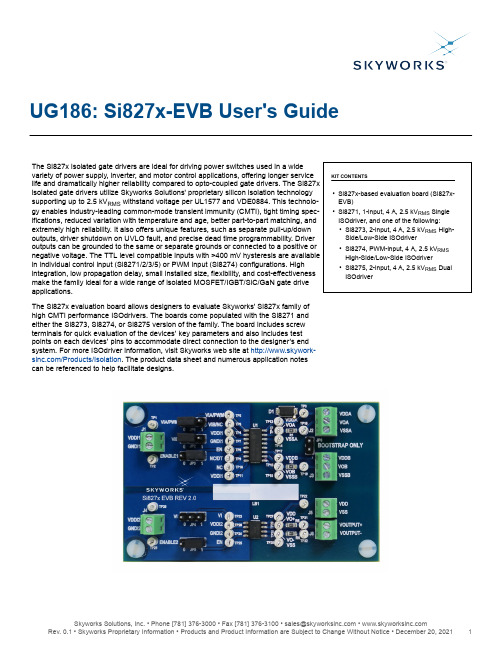
UG186: Si827x-EVB User's GuideThe Si827x isolated gate drivers are ideal for driving power switches used in a widevariety of power supply, inverter, and motor control applications, offering longer servicelife and dramatically higher reliability compared to opto-coupled gate drivers. The Si827xisolated gate drivers utilize Skyworks Solutions' proprietary silicon isolation technologysupporting up to 2.5 kV RMS withstand voltage per UL1577 and VDE0884. This technolo-gy enables industry-leading common-mode transient immunity (CMTI), tight timing spec-ifications, reduced variation with temperature and age, better part-to-part matching, andextremely high reliability. It also offers unique features, such as separate pull-up/downoutputs, driver shutdown on UVLO fault, and precise dead time programmability. Driveroutputs can be grounded to the same or separate grounds or connected to a positive ornegative voltage. The TTL level compatible inputs with >400 mV hysteresis are availablein individual control input (Si8271/2/3/5) or PWM input (Si8274) configurations. Highintegration, low propagation delay, small installed size, flexibility, and cost-effectivenessmake the family ideal for a wide range of isolated MOSFET/IGBT/SiC/GaN gate driveapplications.The Si827x evaluation board allows designers to evaluate Skyworks' Si827x family ofhigh CMTI performance ISOdrivers. The boards come populated with the Si8271 andeither the Si8273, Si8274, or Si8275 version of the family. The board includes screwterminals for quick evaluation of the devices’ key parameters and also includes testpoints on each devices’ pins to accommodate direct connection to the designer’s endsystem. For more ISOdriver information, visit Skyworks web site at http://www.skywork-/Products/Isolation . The product data sheet and numerous application notescan be referenced to help facilitate designs.KIT CONTENTS•Si827x-based evaluation board (Si827x-EVB)•Si8271, 1-input, 4 A, 2.5 kV RMS Single ISOdriver, and one of the following:•Si8273, 2-input, 4 A, 2.5 kV RMS High-Side/Low-Side ISOdriver •Si8274, PWM-input, 4 A, 2.5 kV RMS High-Side/Low-Side ISOdriver •Si8275, 2-input, 4 A, 2.5 kV RMS Dual ISOdriverUG186: Si827x-EVB User's Guide • Required Equipment1. Required EquipmentThe following equipment is required to demonstrate the evaluation board:• 1 digital multimeter• 1 oscilloscope (at least 2 channel)• 1 dual dc power supply: 0–5 V and 0–15 V (or 2 single supplies)• 1 function generator•Assorted cables, leads and probes as necessary to connect equipment to EVB•Si827x Evaluation Board (board under test)•Si827x Evaluation Board User's Guide (this document)Note: Please note the voltage rating for the prepopulated components in the Si827x BOM section of this document before applying power to the ISOdriver and customer-specific output power stage. Applying a voltage to a component that is higher than its rating can cause permanent device damage. If the installed components do not meet the user's requirements, these components need to be replaced before proceeding.2. Si827x ISOdriver Board Setup and Demo Test2.1 EVB Demo/TestTo run the demo, follow the instructions below. Refer to Figure 3.1 Si827x Evaluation Board Primary Silkscreen on page 7 and Figure 3.2 7 on page 8 as necessary.2.2 DC Supply Configuration1.Set one supply to output 5 VDC.2.Turn OFF the supply and connect the positive lead to VDDI (J1 pin1 or TP1).3.Connect the negative lead to GNDI (J1 pin 2 or TP2).4.Turn ON the dc power supply.5.Ensure that the current draw is less than 25 mA. If it is larger, this indicates that either the board or Si827x has been damaged orthe supply is connected backwards.6.Set the other supply to output 15 VDC.7.Turn OFF the supply and connect the positive lead to VDDA (J2 pin 3 or TP3).8.Connect the negative lead to VSSA (J2 pin 1 or TP15).9.Turn ON the supply.10.Ensure that the current draw is less than 100 mA. If it is larger, this indicates that either the board or Si827x has been damaged orthe supply is connected backwards.2.3 Function Generator1.Turn ON the function generator with the output disabled.2.Adjust its output to provide a 500 kHz, 0 to 5 V peak square wave (50 percent duty cycle) to its output.3.Connect the output of the generator to VIA/PWM (JP1 pin2).4.If this is a board with VIB, apply a jumper to JP2 between pins 2 and 3.5.Make sure jumper JP3 has a shunt between pins 1 and 2 to enable the device.6.Enable the output of the waveform generator.2.4 Oscilloscope SetupTo set up the oscilloscope, perform the following steps:1.Turn ON the oscilloscope.2.Set the scope to Trigger on CH1 and adjust the trigger level to approximately 2 V.3.Set CH1 to 2 V per division and CH2 to 5 V per division.4.Adjust the seconds/division setting to 500 ns/division.5.Connect the scope channel 1 probe to VIA/PWM. Ground the probe to GNDI.6.Connect Channel 2 probe to VOA (J2 pin2 or TP15). Ground the probe to VSSA.7.Adjust the vertical position of each channel to properly view each channel as shown in the figure below.A 500 kHz square wave should display on Channel 1 of the scope for the input and a 15 V version should display on Channel 2, as shown in the following figure.Figure 2.1. 500 kHz Square Wave2.5 Repeat for Second Channel1.Disable the function generator output.2.Turn OFF the 15 V supply.3.Disconnect 15 V supply from VDDA/VSSA.4.Connect the 15 V supply to VDDB and VSSB (J3 pins 3 and 1 or TP17 and TP18).5.Move the channel 2 scope probe to VOB/VSSB (J3 pin 2/1 or TP19/TP18).6.Move the function generator to VIB (JP2 pin 2 or TP6). NOTE: If this board is populated with the Si8274 device, leave the functiongenerator connected to VIA/PWM. Otherwise, move the shunt from JP2 to JP1.7.Turn ON the dc supply.8.Ensure that the current draw is less than 100 mA. If it is larger, this indicates that either the board or Si827x has been damaged orthe supply is connected backwards.9.Enable the function generator output.10.The scope display should show both the input and output waveforms as before. NOTE: If this board is populated with the Si8274device, the output waveform will be inverted with respect to the input.2.6 Test the Si82711.Disable the function generator output.2.Turn OFF the 15 V supply.3.Turn OFF the 5 V supply.4.Disconnect 15 V supply from VDDA/VSSA.5.Connect the 15 V supply to VDD and VSS (J5 pins 2 and 1 or TP22 and TP28).6.Connect the 5 V supply to VDDI2 and GNDI2 (J4 pins 1 and 2 or TP20 and TP21).7.Short the VOUTPUT+ and VOUTPUT- pins together (J6 pins 1 and 2) and connect them to the channel 2 scope probe.8.Ground the probe at VSS (J5 pin 1 or TP28).9.Move the function generator to VI (JP4 pin 2 or TP23).10.Move the channel 1 scope probe to be connected to the same points as the function generator.11.Make sure jumper JP5 has a shunt between pins 1 and 2 to enable the device.12.Turn ON the dc supplies.13.Ensure that the current draw is less than 100 mA on the 15 V supply and 25 mA on the 5 V supply. If either is larger, this indicatesthat either the board or Si827x has been damaged or the supply is connected backwards.14.Enable the function generator output.15.The scope display should show both the input and output waveforms as before.3. Si827x-EVB Power and Jumper Connection DescriptionsThe power and jumper connections are summarized here:•J1 Screw terminal block used to connect external power supply for input side of Si827x.•J2 Screw terminal block used to connect external power supply for output side A as well as bring out output A of Si827x.•J3 Screw terminal block used to connect external power supply for output side B as well as bring out output B of Si827x.•J4 Screw terminal block used to connect external power supply for input side of Si8271.•J5 Screw terminal block used to connect external power supply for output side of Si8271.•J6 Screw terminal block used to bring out V+ and V– outputs of Si8271.•JP1 Header to facilitate connection of external signal for VIA/PWM of Si827x.•JP2 Header to facilitate connection of external signal for VIB of Si827x (not populated for Si8274 version of EVB).•JP3 Header to facilitate connection of external signal for ENABLE of Si827x.•JP4 Header to facilitate connection of external signal for VI Si8271.•JP5 Header to facilitate connection of external signal for ENABLE of Si8271.•JP6 Header to facilitate evaluation of BOOTSTRAP circuitry.3.1 Voltage and Current Sense Test PointsThe Si827x evaluation board has several test points. These test points correspond to the respective pins on the Si827x integrated circuits as well as other useful inspection points. See the figure below for a silkscreen overview. See the schematic drawings for more details.Figure 3.1. Si827x Evaluation Board Primary SilkscreenFigure 3.2. Si827x Evaluation Board Secondary Silkscreen4. Si827x Evaluation Board SchematicsFigure 4.1. Si827x Evaluation Board Schematic (1 of 2)Figure 4.2. Si827x Evaluation Board Schematic (2 of 2)UG186: Si827x-EVB User's Guide • Si827x Evaluation Board Schematics5. Si827x Evaluation Board LayoutFigure 5.1. Si827x Layer 1: Primary SideUG186: Si827x-EVB User's Guide • Si827x Evaluation Board LayoutFigure 5.2. Si827x Layer 2: Ground PlaneFigure 5.3. Si827x Layer 3: Power PlaneFigure 5.4. Si827x Layer 4: Secondary Side6. Bill of MaterialsTable 6.1. Si827x-EVB Bill of Materials7. Ordering GuideTable 7.1. Si827x ISOdriver EVB Ordering GuideCopyright © 2021 Skyworks Solutions, Inc. All Rights Reserved.Information in this document is provided in connection with Skyworks Solutions, Inc. (“Skyworks”) products or services. These materials, including the information contained herein, are provided by Skyworks as a service to its customers and may be used for informational purposes only by the customer. Skyworks assumes no responsibility for errors or omissions in these materials or the information contained herein. Skyworks may change its documentation, products, services, specifications or product descriptions at any time, without notice. Skyworks makes no commitment to update the materials or information and shall have no responsibility whatsoever for conflicts, incompatibilities, or other difficulties arising from any future changes.No license, whether express, implied, by estoppel or otherwise, is granted to any intellectual property rights by this document. Skyworks assumes no liability for any materials, products or information provided hereunder, including the sale, distribution, reproduction or use of Skyworks products, information or materials, except as may be provided in Skyworks’ Terms and Conditions of Sale.THE MATERIALS, PRODUCTS AND INFORMATION ARE PROVIDED “AS IS” WITHOUT WARRANTY OF ANY KIND, WHETHER EXPRESS, IMPLIED, STATUTORY, OR OTHERWISE, INCLUDING FITNESS FOR A PARTICULAR PURPOSE OR USE, MERCHANTABILITY, PERFORMANCE, QUALITY OR NON-INFRINGEMENT OF ANY INTELLECTUAL PROPERTY RIGHT; ALL SUCH WARRANTIES ARE HEREBY EXPRESSLY DISCLAIMED. SKYWORKS DOES NOT WARRANT THE ACCURACY OR COMPLETENESS OF THE INFORMATION, TEXT, GRAPHICS OR OTHER ITEMS CONTAINED WITHIN THESE MATERIALS. SKYWORKS SHALL NOT BE LIABLE FOR ANY DAMAGES, INCLUDING BUT NOT LIMITED TO ANY SPECIAL, INDIRECT, INCIDENTAL, STATUTORY, OR CONSEQUENTIAL DAMAGES, INCLUDING WITHOUT LIMITATION, LOST REVENUES OR LOST PROFITS THAT MAY RESULT FROM THE USE OF THE MATERIALS OR INFORMATION, WHETHER OR NOT THE RECIPIENT OF MATERIALS HAS BEEN ADVISED OF THE POSSIBILITY OF SUCH DAMAGE.Skyworks products are not intended for use in medical, lifesaving or life-sustaining applications, or other equipment in which the failure of the Skyworks products could lead to personal injury, death, physical or environmental damage. Skyworks customers using or selling Skyworks products for use in such applications do so at their own risk and agree to fully indemnify Skyworks for any damages resulting from such improper use or sale.Customers are responsible for their products and applications using Skyworks products, which may deviate from published specifications as a result of design defects, errors, or operation of products outside of published parameters or design specifications. Customers should include design and operating safeguards to minimize these and other risks. Skyworks assumes no liability for applications assistance, customer product design, or damage to any equipment resulting from the use of Skyworks products outside of Skyworks’ published specifications or parameters.Skyworks, the Skyworks symbol, Sky5®, SkyOne ®, SkyBlue™, Skyworks Green™, Clockbuilder ®, DSPLL ®, ISOmodem ®, ProSLIC ®, and SiPHY ® are trademarks or registered trademarks of Skyworks Solutions, Inc. or its subsidiaries in the United States and other countries. Third-party brands and names are for identification purposes only and are the property of their respective owners. Additional information, including relevant terms and conditions, posted at , are incorporated by reference.PortfolioQuality/qualitySupport & Resources/support。
中国电信商务领航2-2型定制网关规格说明书v2.0

7.12.1. 7.12.2. 7.12.3. 7.12.4. 7.12.5. 7.12.6. 7.12.7.
基本防火墙功能.....................................................................................................19 访问控制功能.........................................................................................................19 内容过滤功能.........................................................................................................20 应用控制功能.........................................................................................................20 入侵防护功能.........................................................................................................20 病毒过滤功能.........................................................................................................21 防内网 ARP 攻击 ...................................................................................................21
中国电信企业网关管理系统技术规格说明书V2.0-南向接口

中国电信集团公司技术标准
Q/CT 2213-2009
中国电信企业网关管理系统技术规格说明书 -南向接口
(v2.0)
2009-12-31 发布
2010-1-1 实施
中国电信集团公司 发布
Hale Waihona Puke Q/CT 2213-2009
目录
前言 ........................................................................................................................................................1
6.3.2 配置要求 ......................................................................................................................13 6.3.2.1 NTP Server 地址配置 ............................................................................................... 13 6.3.2.2 WLAN 配置...................................................................................................................... 13 6.3.2.3 重启.................................................................................................................................... 13 6.3.2.4 设备信息通告周期(可选支持)..................................................................... 13
FH-AP2400(27G0T2)一体化室内无线接入点用户手_册

b) 请不要将配套提供的 48V POE 电源适配器直接插入 12V Power 口供电,否则设备会损坏! c) 请使用稳定的电网给设备供电,不稳定的电网会造成设备工作异常;设备支持 PoE 供电,
fhap240027g0t2fhap240027g0t2一体化室内无线接入点用户手fhap240027g0t2fhap240027g0t2一体化室内无线接入点用户手本公司的用户手册并无任何明确或隐含的保证包括为了特殊目的进行销售或安装的保证
FH-AP2400(27G0T2)一体化室内无线接入点用户手 册
FH-AP2400(27G0T2) 增强型室内无线 接入点
用户手册
FH-AP2400(27G0T2)一体化室内无线接入点用户手 册
虹信通讯股份有限公司
FH-AP2400(27G0T2) 增强型室内无线接入点用户手册
本资料著作权属虹信通讯股份有限公司所有。未经著作权人书面许可,任何单位 或个人不得以任何方式摘录、复制或翻译。 侵权必究。
4.3.1 连接无线交换机方式............................................................................................................... 9 4.3.2 瘦 AP 的时区/时间设置......................................................................................................... 10 4.3.3 瘦 AP 的管理 VLAN ID ........................................................................................................ 10 4.4 胖 AP 基本配置................................................................................................................................. 10 4.4.1 用户名..................................................................................................................................... 12 4.4.2 接入点名字............................................................................................................................. 13 4.4.3 国家/区域................................................................................................................................ 13 4.4.4 有线端速率............................................................................................................................. 13 4.4.5 配置 AP 作为.......................................................................................................................... 13 4.4.6 IP 地址 .................................................................................................................................... 14 4.4.7 生成树协议............................................................................................................................. 14 4.5 胖 AP 无线参数设置......................................................................................................................... 14 4.5.1 操作模式................................................................................................................................. 15 4.5.2 无线模式................................................................................................................................. 15 4.5.3 信道/频率................................................................................................................................ 15 4.5.4 数据率..................................................................................................................................... 16 4.5.5 输出功率................................................................................................................................. 16 4.5.6 CTS 模式 ................................................................................................................................ 16 4.5.7 RTS 阈值................................................................................................................................. 16 4.5.8 分片长度................................................................................................................................. 16 4.5.9 信标间隔................................................................................................................................. 16 4.5.10 DTIM 时间间隔.................................................................................................................... 16 4.5.11 前导帧类型 ........................................................................................................................... 17 4.5.12 无线距离............................................................................................................................... 17
徐州阿卡827智能定位器使用说明书2
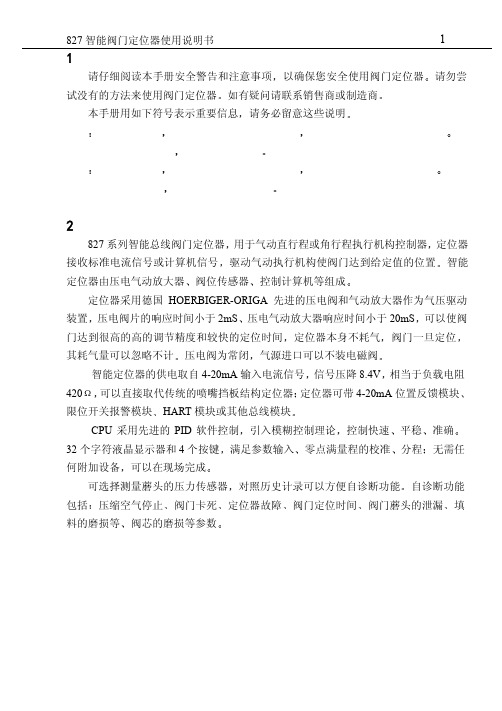
角行程范围 20-100 度
输入信号
4-20mA 二线制 工作电源取自信号 压降 8.4V 负载电阻在 20mA 时相当于
420 最小维持工作电流 3.5mA 允许浮地 负载电阻最小可以做到
300 需要请在订货时说明
防爆标志 EXiaIICT6 Ui=28VDC Ii=93mA Pi=0.65W Ci=0uF Li=52uH
直行程
角行程
分程
蘑头尺寸选择
死区选择
正反作用
Hale Waihona Puke 自动测试校准灵敏度选择
预设流量曲线和自定义流量曲线
调用工厂设定参数
827 智能阀门定位器使用说明书
14
正常运行 LCD 显示内容
正常运行时 LCD 显示内容如下 以 827-A 为例
表示输入电流
表示理论阀位
I= 12.0mA Q= 50.0% 50% OK Lin_W/+
或有无压缩空气供应
独立的 4-20mA 位置反馈模块 模块含独立的 CPU 控制电路 不管定位器正常 或故障 位置反馈模块都能反映阀门正常位置 请在订货时说明
限位开关 报警模块
1 工作电压 9-36VDC 2 开关 报警输出 输出均为 NPN 集电极开路输出 每路最大电流 0.4A 定
位器内有指示灯指示开关的状态 2 路限位开关设定范围
可选择测量蘑头的压力传感器 对照历史计录可以方便自诊断功能 自诊断功能 包括 压缩空气停止 阀门卡死 定位器故障 阀门定位时间 阀门蘑头的泄漏 填 料的磨损等 阀芯的磨损等参数
827 智能阀门定位器使用说明书
2
图 1 智能总线阀门定位器方框图
827 智能阀门定位器使用说明书
3
- 1、下载文档前请自行甄别文档内容的完整性,平台不提供额外的编辑、内容补充、找答案等附加服务。
- 2、"仅部分预览"的文档,不可在线预览部分如存在完整性等问题,可反馈申请退款(可完整预览的文档不适用该条件!)。
- 3、如文档侵犯您的权益,请联系客服反馈,我们会尽快为您处理(人工客服工作时间:9:00-18:30)。
一.产品安装、使用安全说明
(一)使用注意事项
1.阅读、遵循并保留说明——操作设备之前,必须阅读并严格遵循安全说明及操作说明的所有要求。
请妥善保留本说明书,以备将来参考。
2.附件——请使用制造商推荐的附件或随产品提供的附件。
3.安装注意事项——请勿将此设备置于不稳定的台面、三脚架、支架或底座上。
防止设备由于掉落而造成的严重人身伤害及设备损坏。
请根据制造商的说明安装设备。
4.所有外接线禁止裸露,接线处和没用到的线头必须用绝缘胶布包扎,用于防止裸线意外的接触,导致设备的损坏。
5.维修——不要尝试自行维修设备。
打开或拆卸可能导致电击或其它危险。
所有维修事项均应交给专业的维修人员处理。
6.需要进行维修的损坏事项——发生以下情况时,请断开设备的交流或直流电源,然后通知专业的维修人员进行维修:-电源线或插头损坏。
-液体溅入设备或有异物落入设备。
-设备被水打湿或曝露在恶劣天气(雨、雪等)中。
-设备掉落或设备性能发生明显变化。
7.替换部件——如果需要替换部件,维修人员必须仅使用制造商指定的替换部件。
8.安全检查——维修设备之后,请让维修人员执行安全检查,确保设备能正常工作。
9.电源——仅使用标签上指明的电源类型操作设备。
如果不确定所用的电源类型请联系相关运营商
(二)安装注意事项
1.所有走线都必须套管,PVC管和镀锌管都可以,避免老鼠
咬断线路引起故障。
虽然WG-827商务网关具备了良好的防静电、
防雷击、防漏电设计,但请务必保证交流电地线连接完善,且交
流电地线真实接地。
2.建议您不要经常带电拔插接线端子;请务必拔下接线端子,
再进行相应的焊接工作。
3.对有强磁干扰的场所,应采用镀锌钢管或屏蔽线敷设并做
接地处理。
4.WG-827商务网关出厂默认IP为192.168.9.243。
计算机
在配置网关IP时,必须与网关在同一网段下,如计算机IP设置
为:192.168.9.123。
5.在配置为出厂状态下的WG-827商务网关时,必须保证在
局域网内只有一台出厂状态下的机器,以避免网络冲突。
6.完成配置网关的IP地址后,请牢记该IP地址,以避免无
法再次登录该网关。
二.产品简介
WG-827商务网关是商务系统的中间控制单元,WG-827商务
网关通过以太网配合GDC2000(6.60版本)一同使用,每台WG-827
商务网关最多可以驱动128台窗口机。
(一)系统功能特点
●采用32位高速CPU;
●支持最多驱动128台窗口机;
●采用以太网通讯技术,保证通讯的可靠性;
●内置硬件看门狗,杜绝死机;
●485通信端口具有抗雷击及浪涌保护功能;
●支持本地Web配置。
(二)主要性能指标
1.工作电源:交流198~242VAC,功率≤5W
2.工作环境:温度0℃~50℃,湿度10~85%RH
3.流水缓存笔数:26万笔
4.以太网通讯:支持10/100M自适应
5.适用于金龙卡收款机类型:SKJ-1-315、SKJ-1-415、
SKJ-1-515、SKJ-1-121、SKJ-1-221或
SKJ-1-112AS/AE
6.产品重量:2.05kg
7.外箱尺寸:330mm(长) * 222mm(宽) * 58mm(高)
(三)控制器指示灯说明
当WG-827商务网关接通电源后,电源指示灯(红灯)和所
有绿色指示灯同时点亮。
隔几秒后绿色指示灯熄灭,电源指示灯
(红灯)常亮,WG-827商务网关最多驱动POS机指示灯常亮(如
WG-827商务网关最多驱动32台POS机,则×32指示灯常亮)。
运行指示灯(绿灯)周期闪烁,表示当前系统正常运行。
当商务
系统启动营业,网关驱动POS时,发送、接收指示灯闪烁。
标号为“1”、“2”的指示灯指示的是网关连接的金龙卡收款
机类型。
“2”指示灯类型为SKJ-1-112AS/AE;“1”指示灯类型
为除SKJ-1-112AS/AE外其它类型。
三.连线、安装
把WG-827商务网关配套的电源线可靠地连接220V交流电,
并把地线真实接地。
把标号“1A-1B”或“2A-2B”
(“1A-1B”、
“2A-2B”
表示端口1或2)的端子连接到RS-485通信网络,注意RS-485
的A、B端,不要反接而影响了准确传输。
“LAN”口接网线。
说明:
RS-485通讯线采用屏蔽电缆,线材建议选用RVVP 2×0.75mm2
RJ45网线遵循ANSI/TIA/EIA-568B标准网线
注:当忘记网关IP时,可以按住“Reset”键然后开机,直到绿色指示灯闪烁。
网关会恢复出厂IP。
四.商务网关系统连网
(一) TCP/IP网络通信方式
运行GDC2000(6.60版本)软件的计算机和WG-827商务网关接入以太网,在计算机运行GDC2000(6.60版本)软件,当WG-827商务网关自动联接后,GDC2000(6.60版本)软件状态栏会显示网关就绪,则可以启动营业,网关会按照配置好的信息工作。
(二) WEB服务
在局域网内找任意一台计算机,把该台计算机IP地址改为192.168.9.123。
再在该计算机IE浏览器的地址栏内输入WG-827商务网关的IP地址(网关初始IP为192.168.9.243),将会出现网关用户登录界面,如下图所示:
在密码栏内输入正确的登录密码(WG-827商务网关初始密码为11111111)会进入WG-827商务网关的基本信息界面,在此界面中可查看WG-827商务网关基本信息,如下图所示:
在WG-827商务网关的基本信息界面点击;会
显示以下界面,可查看其系统配置信息及机器日期和时间
在网络配置页内点击,所有系统配置将恢
复到出厂设置。
WG-827商务网关会重启。
在网络配置页内点击,会安全退出网络配置页,
再次进入必须重新进行系统登录。
在网络配置页内点击,将进入网络配置修
改页面,如图
在本机IP,子网掩码,服务器IP,网关节点号以及密码修
改等栏内利用计算机键盘输入所要修改的值,点选POS类型,按
“更新设置”,则网关自动完成设置好的更改,然后网关重启。
注:
⏹一定要记住密码,以便下次登录。
⏹POS类型是指网关当前连接的金龙卡收款机类型,请
一定确认,否则RS-485无法通讯。
⏹服务器端号、网关端口号没有特殊需要可以不填,保
持网关初始值,静态密钥要与GDC2000中的节点通信
密钥相一致(如下图)。
制造商:哈尔滨新中新电子股份有限公司
生产商:哈尔滨新中新华科电子设备有限公司
地址:哈尔滨市南岗区学府路副380号。
